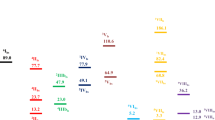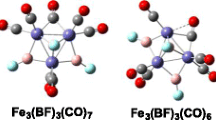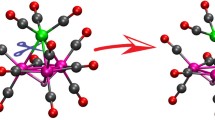Abstract
The binuclear iron complexes (CH3CN)2Fe2(CO) n (n = 7, 6), containing both the strongly back-bonding CO ligand and the weakly back-bonding acetonitrile ligand, have been investigated by density functional theory. The acetonitrile ligands are always found to be terminal in such structures. Heptacarbonyl structures are found at similar energies, with both acetonitrile ligands bonded to the same iron atom or with each acetonitrile ligand bonded to a different iron atom. Various combinations of bridging and semibridging CO groups are found in these (CH3CN)2Fe2(CO)7 structures approaching triply (bridged + semibridged) structures for the structures with symmetrically distributed acetonitrile ligands. The latter structures thus resemble the well-established triply bridged structure for the related binary iron carbonyl Fe2(CO)9. For the hexacarbonyl (CH3CN)2Fe2(CO)6, both triplet unbridged structures and singlet doubly bridged structures are found. The triplet (CH3CN)2Fe2(CO)6 structures have slightly lower energies relative to the singlet structures.
Graphical abstract
The acetonitrile ligands in (CH3CN)2Fe2(CO) n (n = 7, 6) are always found to be terminal ligands. Various combinations of bridging and semibridging CO groups are found in these (CH3CN)2Fe2(CO)7 structures approaching triply (bridged + semibridged) structures for the structures with symmetrically distributed acetonitrile ligands. For the hexacarbonyl (CH3CN)2Fe2(CO)6, both triplet unbridged structures and singlet doubly bridged structures are found.







Similar content being viewed by others
References
Mond L, Langer C, Quinncke F (1890) J Chem Soc 57:749
Calderazzo F (2005) In: King RB (ed) Encyclopedia of inorganic chemistry, vol 2. Wiley, Chichester, pp 764–781
Szilagyi RK, Frenking G (1997) Organometallics 126:4807
Diefenbach A, Bickelhaupt FM, Frenking G (2000) J Am Chem Soc 122:6449
Treichel PM (1973) Adv Organomet Chem 11:21
Yamamoto Y (1980) Coord Chem Revs 32:193
Singleton E, Oosthuizen HE (1983) Adv Organomet Chem 22:209
Kharasch MS, Seyler RC, Mayo FR (1938) J Am Chem Soc 60:882
Tate DP, Augl JM, Knipple WR (1962) Inorg Chem 1:433
King RB, Fronzaglia A (1966) Inorg Chem 5:1837
Koelle U (1978) J Organomet Chem 155:53
Poliakoff M, Turner JJ (1971) J Chem Soc A 2403
Fletcher SC, Poliakoff M, Turner JJ (1986) Inorg Chem 25:3597
Fedrigo S, Haslett TL, Moskovits M (1996) J Am Chem Soc 118:5083
Schubert EH, Sheline RK (1971) Inorg Chem 5:1071
Wang J, Li G, Li Qs, Xie Y, King RB (2012) Polyhedron 47:165
Ziegler T, Autschbach J (2005) Chem Rev 105:2695
Bühl M, Kabrede HJ (2006) Chem Theory Comput 2:1282
Brynda M, Gagliardi L, Widmark PO, Power PP, Roos BO (2006) Angew Chem Int Ed 45:3804
Sieffert N, Bühl M (2010) J Am Chem Soc 132:8056
Schyman P, Lai W, Chen H, Wang Y, Shaik S (2011) J Am Chem Soc 133:7977
Adams RD, Pearl WC, Wong YO, Zhang Q, Hall MB, Walensky JR (2011) J Am Chem Soc 133:12994
Lonsdale R, Olah J, Mulholland AJ, Harvey JN (2011) J Am Chem Soc 133:15464
Becke AD (1993) J Chem Phys 98:5648
Lee C, Yang W, Parr RG (1988) Phys Rev B 37:785
Becke AD (1988) Phys Rev A 38:3098
Perdew JP (1986) Phys Rev B 33:8822
Reiher M, Salomon O, Hess BA (2001) Theor Chem Acc 107:48
Salomon O, Reiher M, Hess BA (2002) J Chem Phys 117:4729
Dunning TH (1970) J Chem Phys 53:2823
Dunning TH, Hay PT (1977) In: Schaefer HF (ed) Methods of electronic structure theory. Plenum, New York, pp 1–27
Huzinaga SJ (1965) Chem Phys 42:1293
Wachters AJH (1970) J Chem Phys 52:1033
Hood DM, Pitzer RM, Schaefer HF (1979) J Chem Phys 71:705
Frisch MJ et al (2004) Gaussian 03, revision D 01. Gaussian, Inc., Wallingford CT (see Supporting Information for details)
Papas BN, Schaefer HF (2006) J Mol Struct 768:275
Cotton FA, Troup JM (1974) J Chem Soc Dalton 800
Caspar JV, Meyer TJ (1980) J Am Chem Soc 102:7794
Hooker RH, Mahmoud KA, Rest AJ (1983) Chem Commun 1022
Hepp AF, Blaha JP, Lewis C, Wrighton MS (1984) Organometallics 3:174
Sunderlin LS, Wang D, Squires RR (1993) J Am Chem Soc 115:12060
Jin R, Chen X, Du Q, Feng H, Xie Y, King RB, Schaefer HF (2012) Organometallics 31:5005
Wang HY, Sun Z, Xie Y, King RB, Schaefer HF (2010) Eur J Inorg Chem 5161
Silaghi-Dumitrescu I, Bitterwolf TE, King RB (2006) J Am Chem Soc 128:5342
Acknowledgments
The research in China was supported by the Guangdong Province Universities and Colleges Pearl River Scholar Funded Scheme (2012), the Research Fund for the Doctoral Program of Higher Education (20104407110007) and the National Natural Science Foundation of China (21273082). Research at the University of Georgia was supported by the US National Science Foundation (Grant CHE-1057466).
Author information
Authors and Affiliations
Corresponding authors
Electronic supplementary material
Below is the link to the electronic supplementary material.
Rights and permissions
About this article
Cite this article
Li, G., Liu, L., Wang, J. et al. Juxtaposition of the strong back-bonding carbonyl ligand and weak back-bonding acetonitrile ligand in binuclear iron complexes. Transition Met Chem 38, 617–625 (2013). https://doi.org/10.1007/s11243-013-9729-1
Received:
Accepted:
Published:
Issue Date:
DOI: https://doi.org/10.1007/s11243-013-9729-1




